DRLO Aviation (part 10)
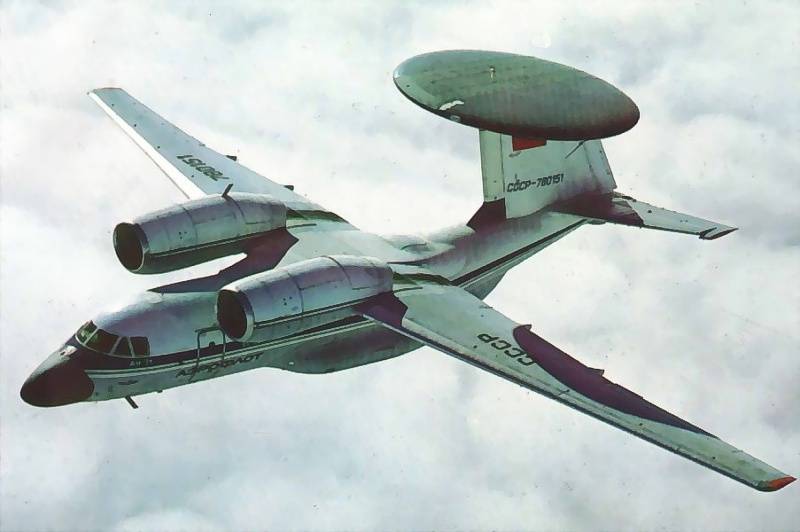
The Soviet military leadership was greatly impressed by the effective use by the Israeli Air Force of American DRLO E-2C Hawkeye aircraft during the Lebanese 1982 war of the year. At that time, the Soviet Union had a limited number of heavy Tu-126, which had already become fairly outdated. To replace outdated machines built in the middle of the 60-x, the development of the aircraft A-50 with the innovative for the USSR radio complex "Bumblebee" was conducted. However, at the design stage of the DRLO aircraft based on the IL-76, it was clear that it could not become inexpensive and massive. In addition to the “strategic” heavy aircraft of the radar patrol and control, the Soviet Air Force needed a tactical vehicle with a flight duration of 4,5 — 5 hours and the possibility of detecting low-flying and unobtrusive targets at long ranges.
In 1983, the command of the Air Force and Air Defense, with the participation of research organizations and industrial enterprises, agreed on the requirements for a new DRLO middle-class aircraft. The airborne radar complex was to provide detection of low-altitude targets at a distance of at least 200 km and simultaneous tracking of 120 targets. In the passive mode, with the help of an electronic reconnaissance station, it was envisaged to detect operating ground (sea) radars and air defense missile systems at a distance of up to 400 km. The data transmission equipment was supposed to provide multi-channel control and guidance of both those in service and advanced fighter-interceptors, as well as the transmission of radar information to ground command posts in real time.
For a promising front-line aircraft, AWACS provided two options for radio systems: decimeter (with the traditional location of the radar antenna in the fairing above the fuselage of the aircraft) and centimeter (with the separation of the antennas in the nose and tail of the fuselage). As aviation platforms were considered: An-12, An-32, An-72 and Il-18. By that time, the An-12 and Il-18 aircraft had already been discontinued, but there were many fairly new and well-maintained vehicles that could easily be converted into AWACS aircraft. The promising medium transport An-32 with the new AI-20D-5M turboprop engines has only been tested. The project based on the light transport An-72 with two double-circuit turbojet engines D-36 seemed very promising. An important advantage of the An-72 was the high location of the engines, which allowed it to be operated from poorly trained field airfields. The use of the so-called Coanda aerodynamic effect seriously increased the lift and reduced the take-off run. Specialists of the OKB Antonov Design Bureau managed to very carefully work out the project, and the military unequivocally spoke out for the option based on the An-72. Thanks to deep preliminary research, it was possible to go directly to the detailed design, bypassing the stages of outline design and construction of a full-sized wooden layout.
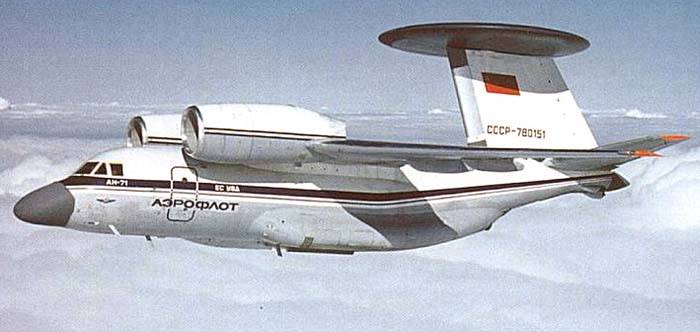
The need to accommodate a disc-shaped antenna for a radio-technical complex predetermined the aerodynamic layout. The large dimensions of the rotating antenna did not allow optimal placement of it on a relatively small plane according to the traditional scheme. In this case, the antenna had a great influence on the tail, and there were zones of radar shading elements of the airframe. In addition, when installing with the help of pylons “on the back”, the antenna inevitably fell under the influence of jet jets of highly located engines. In this regard, after analyzing all possible schemes, the developers stopped at the option of installing an antenna at the tip of the vertical tail, which gave the aircraft a very exotic look. The rotating antenna of the surveillance radar was located inside the fairing, structurally consisting of a metal caisson part and fiberglass shells.
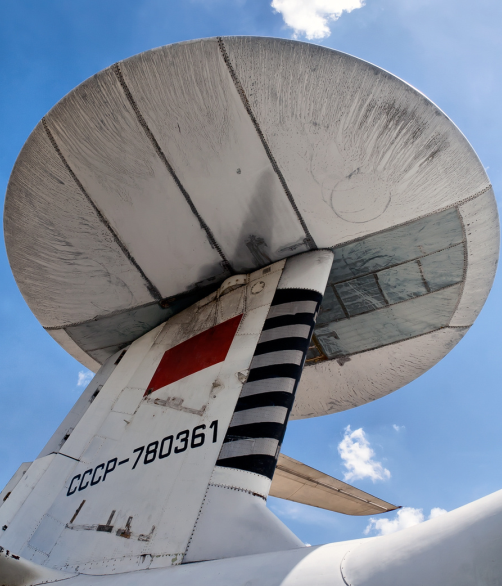
To do this, we had to redo the rear part of the fuselage and the new vertical tail, which had a reverse sweep, as well as a large chord and thickness. To reduce vibration loads, the rear part of the fuselage was raised upwards, which made it possible to increase the height of the stabilizer by half a meter. But even so, despite all the efforts, the handling of the An-71 was noticeably different from the An-72 for the worse. The unusual layout led to the need to solve a number of problems, among which were insufficient stability and control in the lateral and longitudinal channels, and the forced installation of a large-area steering wheel, which complicated management and significantly reduced the effectiveness of the steering trimmer.
To improve the take-off performance on the An-71, more powerful D-436K engines were used with a load of 7500 kg. However, at the request of the military, in order to realize the possibility of taking off from a shortened runway or with one main engine not working, an additional RD-36А engine with 2900 kg was installed under the rear fuselage. Since the power consumption of onboard equipment increased significantly instead of the two GP-21 generators used on the An-72, four GP-23 generators with a total power of 240 kW were used.
Compared with the transport An-72, the internal volume of the An-71 has undergone a reconfiguration. Designers had to go to a number of tricks to accommodate all the necessary equipment and the fuselage was now divided into three compartments. Immediately after the pilot's cabin, there were operators' workplaces with equipment racks and information display screens. In the middle compartment, isolated from the habitable space, there was the computing equipment of the radio-technical complex and the aircraft equipment. The third compartment contained the radar equipment, the upper stage engine, cooling systems and elements of the control system. A metal shielded partition with a door was installed between the first and second compartments.
In order to increase the reliability of the radar complex and reduce the harmful vibration effect, the equipment installed in the third compartment was located on a single cushioning platform, which also served as the air duct of the cooling system. A part of the equipment was placed in the underfloor space of the fuselage, under the chassis and around the wing wings. Thus, the installation density on the An-71 was significantly higher than on the much larger A-50 aircraft. To get to a failed electronic unit, it was often necessary to dismantle several neighboring ones. But it was still necessary to ensure acceptable working conditions for the three operators.
Based on the operating experience of the first Tu-126, great attention was paid to measures to ensure bio-protection and normal crew living conditions. In order to prevent the penetration of harmful high-frequency radiation, the glazing of the cockpit with protective metallized spraying was used, as well as pipelines, electrical cables and bridges through partitions and airframe elements of the aircraft were carried out with compulsory compliance with the requirements of radio hermeticity.
After the final approval of the project, construction of three experimental machines began. Two planes were supposed to be used for flight, and one for static tests. The first An-71 came from the fourth experienced An-72. This machine, which had a large plaque and one emergency landing was before the alteration is not in flying condition. The second and third copies were also not rebuilt, but were reworked from second-hand An-72. 12 July 1985, the experienced An-71 first took to the air.

If the re-equipment of the aircraft themselves went strictly according to the schedule, then there were problems with the radio engineering complex. The first version of the radar and computing complex created in the NGO "Vega" showed unsatisfactory results in terms of detecting air targets against the background of the earth. This led to a radical alteration of radar and computing equipment. However, by that time, the requirements of the customer in terms of interaction with fighter and attack aircraft had changed. It was necessary to increase the number of channels of guidance, to ensure interaction with long-range air defense systems, to increase the degree of automation of operators and to work effectively on ground and surface targets, which led to the creation of a third set of equipment.
Tests of An-71 were carried out not only in Ukraine, but also in other regions of the USSR, including the Caucasus, the Volga region and Central Asia, in various weather conditions and over different landscapes. During the tests, the hardware of the radar complex was brought to a high level of reliability. In this case, An-71 for a month could act in isolation from the main base, doing the minimum maintenance. According to the military and specialists of the Ministry of Aviation Industry, who participated in the tests, the use of An-71 could increase the effectiveness of the actions of fighter aircraft in 2,5-3 times.
On tests, the aircraft with a maximum take-off weight of 32100 kg developed a maximum speed of 650 km / h. Cruising speed - 530 km / h. Practical ceiling - 10800 meters. Time spent on patrol is 5 hours. That is, according to flight data of An-71, at least not inferior to the American E-2С Hawkeye. According to information published by Global Security, a radar installed on the An-71 could detect targets against the background of the earth at a distance of more than 200 km, with an altitude patrol of 8500 meters.
You can often hear the opinion that the An-71 was originally designed as a deck-mounted AWACS aircraft, but this is not the case. In 1982, after laying a heavy aircraft carrier cruiser, 1143.5, on the stockpile of the Black Sea Shipbuilding Plant in Nikolaev, the question arose of forming its wing. If everything was more or less clear with fighters and anti-submarine and rescue helicopters, at that time there were no ready-made candidates for the role of deck-based AWACS aircraft.
In the 1983 year, after the start of work on the front-line DRLO plane, the An-71 deck modification was developed. However, it soon became clear that, due to the great height of the An-71, basing it on an aircraft-carrying cruiser is extremely difficult. If the wings to save space could still be folded, then what to do with high tail feathers, topped with a bulky radar antenna, was not clear. However, the main obstacle was the absence of a catapult on the ship. This made it impossible to take off An-71 from the deck due to insufficient thrust-to-weight ratio. For a short take-off from the strip with a springboard section, at least three booster engines were required, for which it was necessary to redesign the entire aircraft. Taking into account these circumstances, the customer in the person of the Ministry of Defense decided to abandon the order to develop the carrier-based AWACS aircraft based on the An-71 and concentrate efforts on another model.
For the first time, the new Soviet DRLO aircraft in the West were talked about in 1986, after visiting M.S. Gorbachev of the Kiev Mechanical Plant, where at the Gostomel airfield, promising aircraft models were shown to the General Secretary of the CPSU Central Committee. At the same time, the tail end of the aircraft carrying the symbolism of Aeroflot with radar radome fell into the lenses of cameras and camcorders.
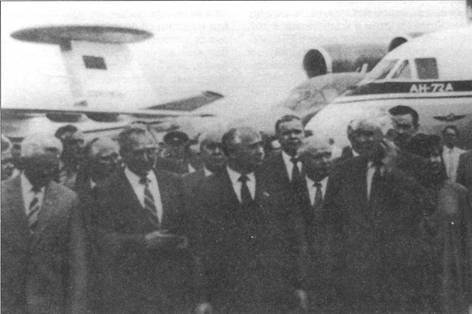
The economic difficulties that the economy faced in the late Soviet period had a negative impact on the fate of An-71. In 1990, work on the An-71, which reached a high degree of readiness, was frozen, and after the collapse of the USSR, in the conditions of loss of financial and economic ties, they were not returned. Although from the point of view of common sense, relatively inexpensive DRLO airplanes of the operational-tactical link are even more necessary for our country than the heavy A-50, mostly idle at the airfield. Having good take-off and landing characteristics and acceptable operating costs, the An-71 could be used as an operational means of enhancing control over the air situation during a “special period” or during local conflicts. During the two Chechen campaigns and the armed conflict with Georgia in 2008, extremely expensive ARLO A-50 aircraft had to be used to guide the actions of combat aviation.
According to American sources, at the beginning of the 2000s, Ukraine was negotiating with India on the possible supply of upgraded An-71 at a price of $ 200 million for one aircraft. At the same time, the Kiev enterprise "Kvant-Radiolocation" undertook to develop a new radar "Kvant-M" with a range of detection of low-altitude targets to 370 km. At the same time, the number of goals followed was to reach 400 units. However, the deal was never concluded. Most likely, the Indian representatives failed to obtain assurances that Ukraine is indeed capable of fulfilling its obligations.
Since 1979, in OKB AS Yakovlev, where traditionally engaged in vertical takeoff and landing of sea-based aircraft, studies were conducted on the DRLO deck aircraft. The main difficulty in creating such a machine, based on the peculiarities of the Soviet aircraft carriers, was the rise of the aircraft into the air in the absence of a catapult on the deck. For this purpose, the thrust of the aircraft, which could spend on patrols 4-5 hours, had to be very high. Initially, the aircraft, designated Yak-44E, provided for the installation of four additional take-off turbojet engines and two cruise missiles. According to the technical task, coordinated with the Navy, the radio-technical complex was to detect air targets at a distance of 150 — 200 km and direct ship fighters at them. The detection range of surface targets - more than 300 km. When stored on a ship, the wing wings folded. The number of crew Yak-44E in the original version - 4 person.
However, the placement of four lifting engines and additional fuel did not leave room for the cumbersome radio engineering complex and normal operating conditions for operators. Yes, the very onboard radar and communications equipment was created with great difficulty. It soon became clear that this version of the DRLO deck aircraft is a dead end, and the project has undergone processing.
On the plane of the updated project, they decided to abandon the additional lifting engines, which were in flight a “dead” cargo. The thrust of the aircraft was increased by installing two new turbofan engines D-27 with 14 000 hp. The choice of this type of engine was due to the fact that at a sufficiently high subsonic cruising speed it had a significantly better fuel efficiency than the available turbojet engines. In addition, in comparison with the turboprop engines on take-off mode, it provided the best traction characteristics, thrust-to-weight ratio and increased lifting force due to the blowing of the wing.
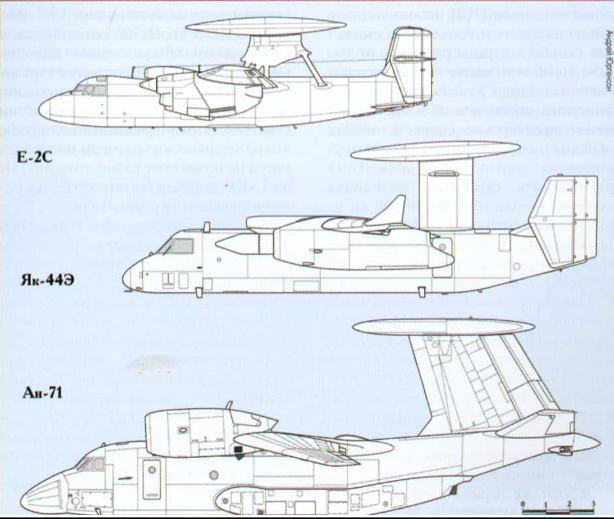
We decided to use the prospective E-700 radar with an antenna in a disk-shaped rotating radome 7,3 with a meter on the pylon above the aircraft fuselage as an onboard circular radar. At the same time, the Soviet carrier-based DRLO aircraft began to resemble the American Hokai very strongly, but at the same time it was somewhat the largest.
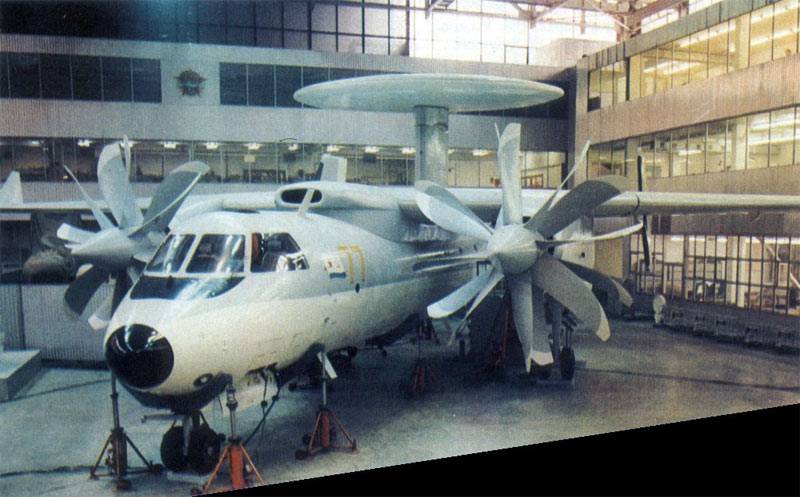
In the summer of 1989, work entered a phase of practical implementation of the project. The first step was the manufacture of a full-size constructive-technological model of the aircraft and a reduced model for radio engineering research and preparation for the construction of prototypes.
For flight tests of aircraft engines D-27 prepared flying laboratory Yak-42LL. The construction of prototypes Yak-44E and its mass production was to be conducted at the Tashkent Aviation Plant. In the future, it was planned that this machine will also be supplied to the Air Force.
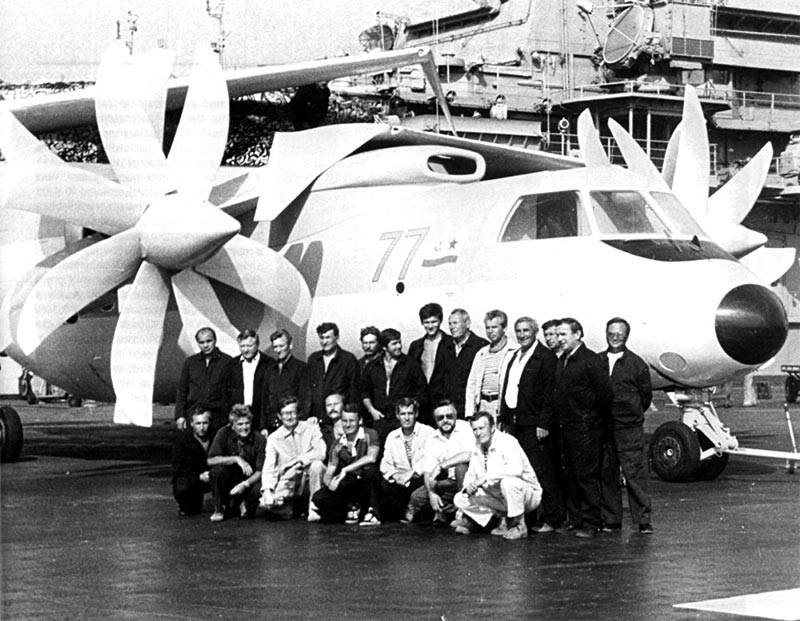
Photo for memory. After completion of testing the Yak-44E on the Tbilisi-carrying aircraft cruiser
In order to assess the possibility of deploying the Yak-44E on the flight deck and in the hangar of the Tbilisi-carrying aircraft cruiser, a full-size mock-up of the aircraft in August 1990 was taken by barge aboard a ship that had been tested in the Sevastopol area. During testing, the possibility of placing the aircraft in the inner hangars, rolling out of the lift and lifting out of the inner hangars, towing and mooring the aircraft on the flight deck and in the hangar, and connecting the aircraft with technical support posts were checked. After the evaluation program was completed, the model was returned to the assembly department of the Yakovlev Design Bureau. After testing the layout of the first prototype took place.
According to design data, the aircraft with a maximum take-off weight of 40 000 kg could reach a maximum speed of 740 km / h. Cruising speed - 700 km / h. Landing speed - 185 km / h. Practical ceiling - 12 000 meters. The duration of patrols at a distance of 300 km from the aircraft carrier in the 500-650 km / h speed range is 5-6 hours. Crew: 2 pilot, 2 RTK operator and guidance officer. Compared with the An-71, the deck Yak-44 was distinguished by a very dense layout.
In the future, to increase the duration of stay in the air, the plane had to get a refueling system. On the basis of the Yak-44E glider also designed deck anti-submarine aircraft and tanker.
E-700 radio complex provided stable detection of air targets against the background of the underlying surface at a distance of 220-250 km, depending on the ESR. Surface targets could be detected at a distance of up to 400 km. The Yak-44 equipment could simultaneously accompany 150 targets and direct 40 fighters at them.
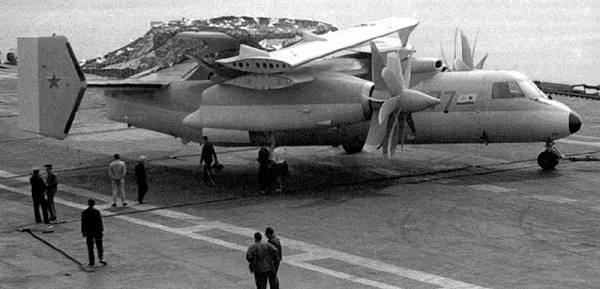
Although the full-scale Yak-44E mock-up was successfully tested on board the 1143.5 aircraft-carrying cruiser, it was clear that on this ship, which also did not have a catapult, the carrier-based AWACS would be too crowded. In total, the wing of the aircraft carrier should have been up to 4 AWACS aircraft and 2 refueling aircraft. Therefore, the design of the deck "radar picket" before the program was closed was mainly carried out in relation to its placement on the nuclear aircraft carrier pr.1143.7 Ulyanovsk. This modification, designed to launch from a catapult, received the designation Yak-44RLD. Unlike the ship now bearing the name Admiral fleet Soviet Union Kuznetsov ”,“ Ulyanovsk ”was to become a full-fledged aircraft carrier with roomy internal hangars and a steam catapult. Its planned commissioning was planned for 1995.
The nuclear aircraft carrier of the Ulyanovsk type could become the first Soviet aircraft carrier, not inferior in size and capabilities of the air group to the American atomic multi-purpose aircraft carrier of the Enterprise and Nimitz types. Installation of steam catapults and the ability to raise DRLOiU aircraft significantly expanded the functions of the ship in comparison with the previous Soviet aircraft-carrying cruisers. In the option of providing air defense of the squadron onboard the Ulyanovsk, it was planned to deploy the 36 Su-33 and 8 Yak-44.
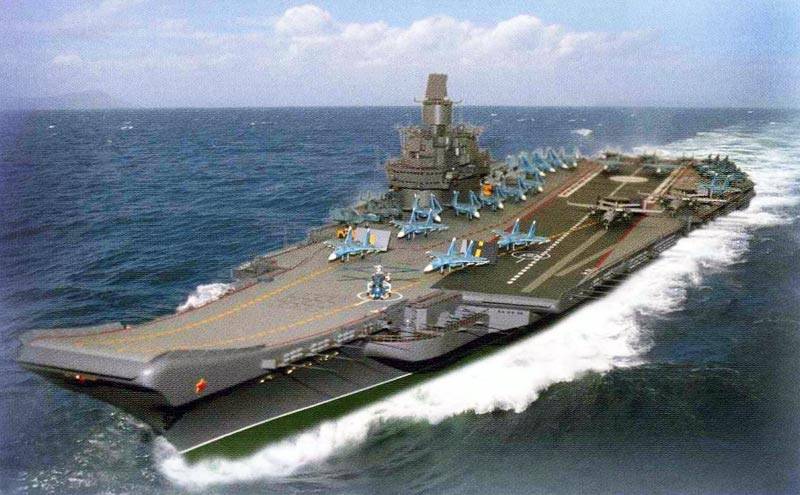
However, after the collapse of the USSR, the construction of the aircraft carrier Ulyanovsk at the shipyard in Nikolaev stopped, and with a readiness level of about 20% the ship's hull was dismantled in 1992 year. At the same time, the government of the “new” Russia stopped funding the Yak-44 program, and this very promising DRLO aircraft was never built. Since the enterprise engaged in the creation of the “front-line” An-71, turned out to be in a “independent” Ukraine, and with the refusal to finance the machine that has become foreign, one can somehow agree, the Yakovlev Design Bureau remained in Russia, and in our country there were all opportunities for the construction of prototypes and fine-tuning to mass production of the Yak-44. Without a doubt, this universal aircraft would be in demand not only in the navy, but also in the air force.
If the An-71 reached the stage of building prototypes, and the Yak-44 was built in the form of a full-size mock-up, then the P-42 aircraft developed by the GM Design Bureau. Beriev in Taganrog, has not left the project stage. This universal aviation platform superficially resembled the American deck-based anti-submarine aircraft S-3 Viking. On the basis of the P-42 was supposed to create an aircraft PLO, tanker, search and rescue, transport and AWACS. Such an approach could save production costs and accelerate the development of flight and technical composition. Like the Viking, it was a monoplane with a top wing of moderate sweep. Two TRDD D-36 located under the wing, the console which could be folded. The keel of the project was also foldable. The plane was supposed to be launched using a ship's catapult and land using an arresting vehicle. It was a fairly compact aircraft with a maximum take-off weight of 29 000 kg and a crew of three people. Its maximum speed was to exceed 800 km / h. Patrol time at a distance of 300 km from the ship - 2,5-3 hours.
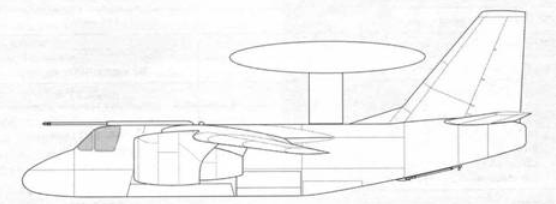
The construction of the prototype was scheduled for 1976 year. It was assumed that the P-42 will be part of the wing of aircraft carriers with a nuclear power plant, etc. 1160 "Eagle". The development of this project was conducted from the end of 60-s in Nevsky PKB. By the middle of the 80-x of the Soviet Navy was to receive three such ships. However, the construction of aircraft carriers with a nuclear reactor was considered too costly, and in 1973, all work was curtailed in favor of the further construction of ships 1143 Ave. Work on the aircraft family P-42 on the paper stage is not advanced.
To be continued ...
Based on:
http://www.yak.ru/DOCS/yak-44.pdf
http://coollib.net/b/166009/read
http://www.globalsecurity.org/military/world/russia/an-71.htm
http://militaryrussia.ru/blog/topic-673.html
http://www.telenir.net/transport_i_aviacija/otechestvennye_samolyoty_i_vertolyoty_drlo/p14.php
- Linnik Sergey
- DRLO Aviation (part 1)
DRLO Aviation (part 2)
DRLO Aviation (part 3)
DRLO Aviation (part 4)
DRLO Aviation (part 5)
DRLO Aviation (part 6)
DRLO Aviation (part 7)
DRLO Aviation (part 8)
DRLO Aviation (part 9)


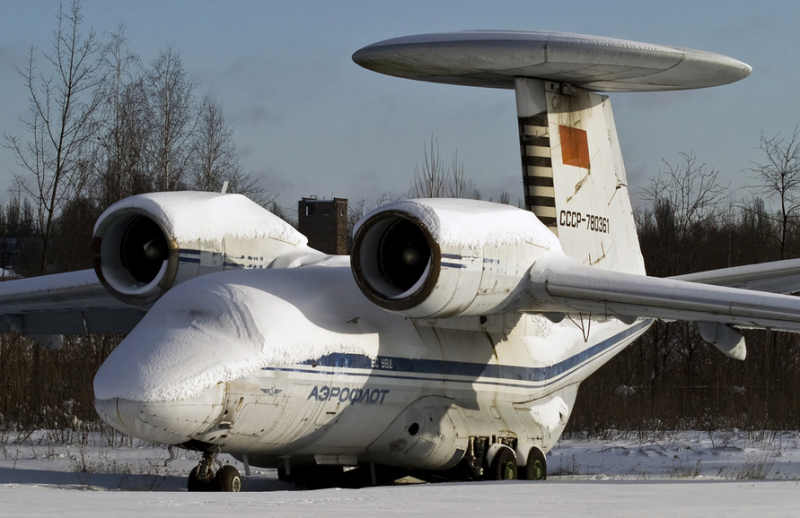
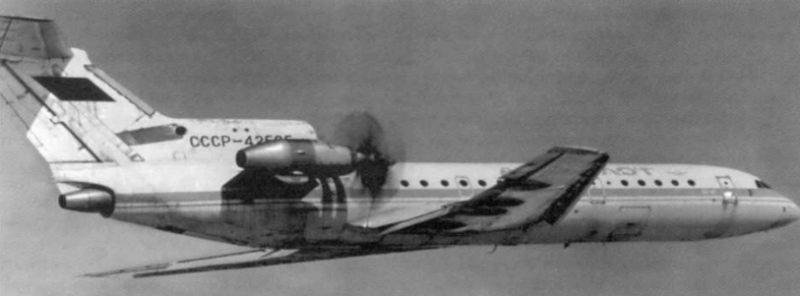
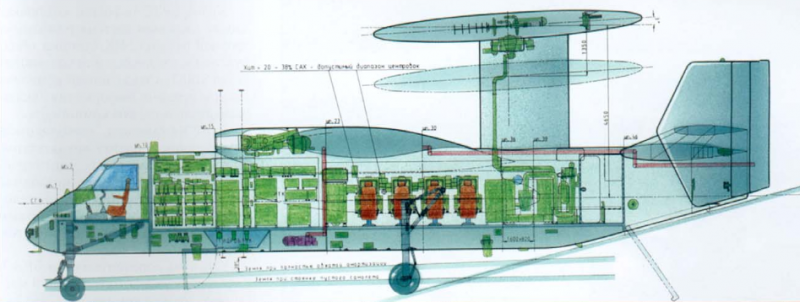
Information